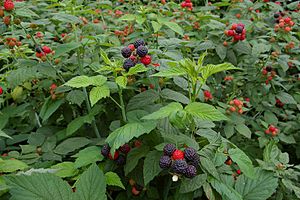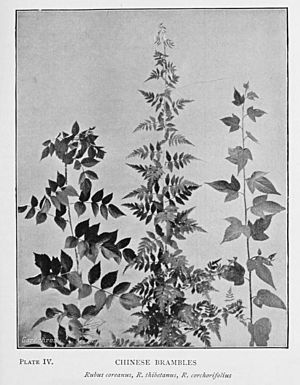Rubus coreanus facts for kids
Quick facts for kids Rubus coreanus |
|
|---|---|
 |
|
| Scientific classification | |
| Genus: |
Rubus
|
| Species: |
coreanus
|
| Synonyms | |
|
|
Rubus coreanus, often called bokbunja (Korean: 복분자), is a type of raspberry. You might also hear it called the Korean blackberry or Korean bramble. This plant grows naturally in Korea, Japan, and China.
It produces yummy berries that look like blackberries. These berries are used to make bokbunja ju (Korean: 복분자주). This is a special Korean fruit wine. Most of the fruit grown for this drink in Korea is actually a different type, Rubus occidentalis, which comes from North America.
The fruits of Rubus coreanus are usually picked between May and July. This is when they are at their best. They can only be grown in a few places in Korea. This is different from Rubus occidentalis, which grows well all over the country.
Discovering Different Raspberry Types
Rubus coreanus is part of a big plant family. This family includes many fruit species that are quite similar. The group of plants called Rubus has about 600 to 800 different kinds. They grow in cool and cold parts of the world.
Fruits from Rubus plants are often known as raspberries. In Europe and the USA, people usually tell them apart by their color. They can be red, black, or purple. About 20 different Rubus species grow naturally in Korea. These include Rubus parvifolius, Rubus crataegifolius, Rubus corchorifolius, Rubus oldhamii, and Rubus coreanus.
Healthy Compounds in Korean Raspberries
Rubus coreanus berries are full of good things for your body. They have many antioxidant compounds. Antioxidants help protect your body's cells.
One important compound found in Rubus coreanus is ellagic acid. This acid is also in other raspberries and many fruits and nuts. People often talk about ellagic acid helping with health.


